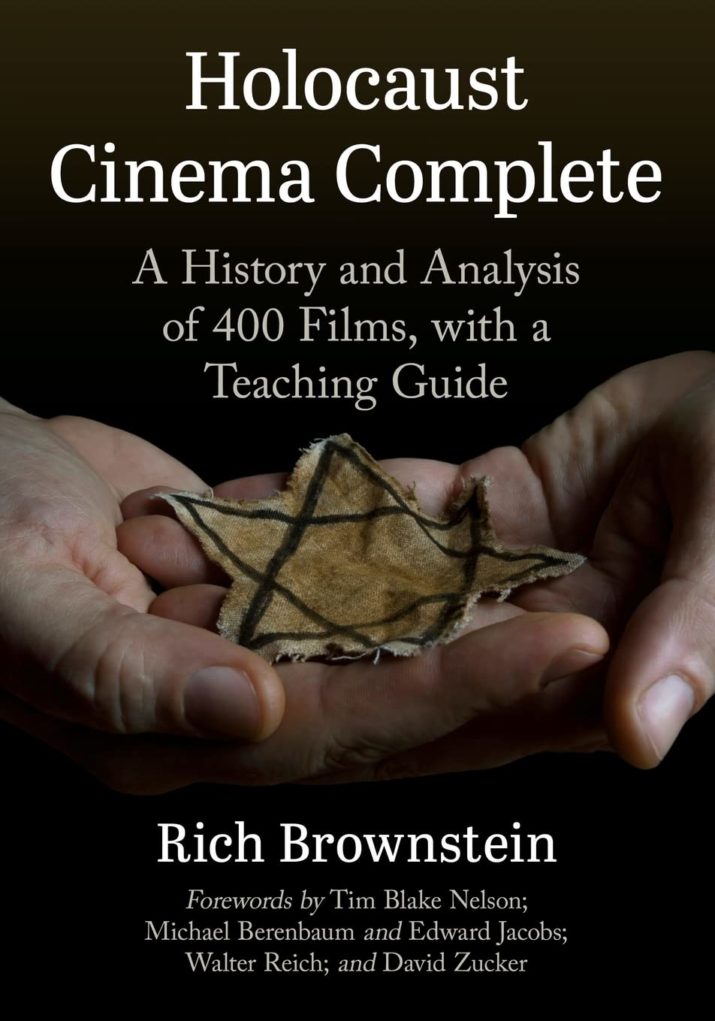
Holocaust Cinema Complete: A History and Analysis of 400 Films, with a Teaching Guide by Rich Brownstein

This is part of our new Campus series, Teaching Genocide.
The book does not shy away from describing a film as “almost incomparably incompetent” (66); and Jojo Rabbit receives some of the harshest condemnation: it is described as “the essence of overt Holocaust commercialization, complete with horrible accents, inappropriate costuming, inane dialogue and anachronistic music” (12). The film is made to stand in for “the danger of letting any yahoo whip up a Holocaust soufflé” (12). The chosen tone in the book indeed occasionally gets carried away: sometimes (ill-begotten?) films receive their due, at other times readers are reminded that they are at a disadvantage compared to the author, who tells them—by means of a general spoiler alert—to “watch the 400 films listed in Appendix I and then continue reading” (12). This cuteness is actually entirely unwanted: Brownstein is knowledgeable about Holocaust film like few others. As a professional working in the film industry and, later, as an educator in Israel teaching about Holocaust film, he is familiar with a very large section of what is (and sometimes, was) available for viewing. This book is the outcome of a very substantial intellectual investment in one of the central cinematic themes since the end of World War II.
One of the many practical aspects to be discovered in this volume is Brownstein’s system for classifying Holocaust films. His “4+1” method differentiates between when a film takes place (either during or after the Holocaust) and who the protagonist is (either Jewish or Gentile). This creates four categories: “Victim”-films are about Jewish protagonists, set during the Holocaust; and “Survivor”-films deal with Jewish protagonists, set afterwards. For Gentile protagonist, the chart provides “Gentile”-films (during) and “Perpetrator”-films (set after the Holocaust). This grid is accompanied by the “plus one” category, here called “Tangential,” in which Brownstein includes films that do not easily fit his four-fold system but nevertheless feature “significant Holocaust content” (23), with Tarantino’s Inglourious Basterds a prime example.
The history of Holocaust films that is presented here remains rather sketchy: it is attached mostly to numerical features and offers a good starting point for a discussion of different phases of Holocaust film, but its lines of division are not well framed in terms of either cinematic aspects of (Holocaust) film making or in relation to larger discussions about the role that Holocaust commemoration has played in public discourse, with possible differences in such contexts as Israel, the US, or Germany. The role, for instance, of the Eichmann trial in Israel or of the building of a Holocaust memorial in Berlin (or the lively debate following the release of Der Untergang) may have shed further light on why the forms of cinematic representation of the Holocaust have developed over the decades in the way they have within distinct cultural contexts.
The focus in Brownstein’s book is often on the production value of certain films: on how well actors deal with particular accents or whether a plot line follows conventions of script writing. Industry standards clearly will play a role in how a film relates to its audience, yet the majority of viewers may not approach films through this kind of angle. Frequently, the discussion of a film consists almost exclusively of some film-industry or production-value aside: rather than being told that, for a particular film, “make-up and lighting were troubling” (95), and then quickly rush on to mention another film, readers may wish for fewer films to be discussed at a more sustained level of engagement. The amount of information the book includes can be overwhelming.
At one point, Brownstein does slow down to discuss individual films, and these sections contain some of the strongest analytical (if at times overtly impressionistic) moments of this volume. In writing about the black holes of Holocaust films, he singles out Schindler’s List, Life is Beautiful, and The Boy in the Striped Pyjamas for special censure. He raises various legitimate points why these films in particular did the cinematic representation of Holocaust some disservice, and this despite the fact that they were very widely viewed and thus increased, substantially, the number of people who went to see the film to learn at least something about the Holocaust. Academic readers active in Holocaust studies will miss a sustained engagement with questions about evil, perpetration, and ethics in general: much recent research (by Erin McGlothlin, Robert Eaglestone, Michael Rothberg, and Joanne Pettitt, to name but a few scholars) has provided frameworks that address the complicated question of how representations of evil work (or fail to). Brownstein’s volume does not pick up on this conversation (or, generally, on the academic tradition of writing about Holocaust film), which is twice regrettable since many of his comments, in particular in the section on Spielberg & Friends, pursue similar ideas.
While this tome certainly covers a vast territory, doing so from the vantage point of a life-time of watching Holocaust films, it does also enter some territory where the author appears equally well-informed, but where the focus on Holocaust film—so strictly adhered to for instance in the choice of films included in this discussion—is less clearly placed. One example for this tendency appears in a longish discussion of Anne Frank’s diary. While films based on her life feature quite prominently in this volume, the discussion of the written account of her life in hiding quite accurately observes that her situation does not quite represent the core of the Holocaust killing machinery. The popularity of her diary may well be due, at least in part, to the fact that it is set during the existence of the death camps, with a Jewish protagonist, but that her own deportation and murder take place, so to say, “off screen.” Brownstein discusses these aspects convincingly, yet one may have wished, despite the prominence of Anne Frank films in the history of cinema that deals with the Nazi history, that the author focused on more cinematic aspects of her story.
The system of ranking is, true to the overall spirit of this book, very comprehensive but also rather impressionistic. While Sophie’s Choice is first excluded as a real Holocaust film, since after all the protagonist is not a Jewish victim, it then features quite prominently as one of the top recommendations. Readers will easily view things differently: why mark as “One of the Best” Harold and Maude, which is only about the Holocaust in a very indirect way, but not even recommend films like Fugitive Pieces or Ida, putting them, in effect, in the lowest category? The overall tone of the book clearly signals to readers that they are presented with a personal best-of list. This is made even more obvious through the table of contents, which already indicates that the author is willing to devote significant time to a few individual films, most prominently The Grey Zone. At times, references to other films amount to little more than name dropping, as in passages such as this: “As with Big Fish (2003), Birdman (2014) and The Shape of Water (2017), The Grey Zone’s theme runs deep, far beyond its title and objects” (139). Such asides feature frequently and leave readers to draw their own conclusions. The praise heaped on Tim Blake Nelson’s film is clearly deserved, given that it was one of the most radical additions to the canon of Holocaust film, due largely to its uncompromising view on what is probably the camps’ most challenging moral aspect, the work of the Sonderkommandos. Yet, it is strange to see that, in the case of this film, the book pardons historical and factual inaccuracies when, with other films, a minor slip occasions strict and even harsh condemnation. The moral high horse that gallops through so many of this book’s chapters also causes Brownstein to engage in a detour into Roman Polanski’s biography, openly addressing the sexual abuse cases attached to his name (also bringing in Woody Allen and Harvey Weinstein, who is merely mentioned in passing). He rightly points out that Leni Riefenstahl’s film work now triggers an immediate moral reaction; yet the conclusion nevertheless states that “The Pianistis a brilliant Holocaust film that becomes more of a teaching tool when considered with the life of its creator, Roman Polanski” (154). In light of this book’s overall willingness to engage in straight talk, Polanski gets away very lightly here.
The amount of material included in the book speaks for itself: the author comes across as a very well-versed historian of Holocaust film, as a film critic who does not shy away from assigning a specific value (even score) to each film. Throughout the book and in the substantial appendix, readers find not simply factual information, such as prizes won (and nominations), but also purely numerical data such as the average rating and number of votes cast for a particular film on IMDb (which may well betray a certain imbalance towards Anglophone contexts). With respect to the running time of films, readers learn, for instance, that “a positive correlation of 0.19 exists between the length of Holocaust films and their IMDb rating” (32). At times, such data is already quite telling, as when the book discusses what from a purely statistical point of view is the unexpected success rates of (American) Holocaust films when it comes to major film prizes, with the Best Foreign Language Oscar featuring prominently in the charts provided in the book. Brownstein’s ire at Spielberg stems, at least in part, from the director’s cultivated move to film Schindler’s List more with an eye on the coveted Oscar than on presenting an ethically responsible treatment of the film’s eponymous hero as a quasi-representative of German perpetrators and beneficiaries. The number of film prizes and viewer preferences, alongside the trust in public taste that seems to lie behind their inclusion, provide some indication of how Holocaust films have fared on the cinematic marketplace; yet Brownstein also points out, quite chillingly, that Holocaust films rarely do well commercially, stating that the film Avengers: Endgame alone “has grossed more than all Holocaust films combined” (112). Academic readers, who address films primarily through the discursive contexts of their own disciplines—be they film, history, or cultural studies—may take other aspects into account in terms of whether particular films are of interest for their own research and teaching. The book sees itself firmly committed to the project of Holocaust education: there is even a separate chapter on curriculum development that addresses issues such as the time to be set aside, classroom management, and other aspects, including a few sample questions and answers on The Grey Zone. First-time teachers of Holocaust-related courses might find helpful guidance here.
Given its sheer scope, Brownstein’s book will be an essential source book for anybody with a serious interest in Holocaust film. It provides an easy-to-navigate access point into some of the more obscure films, with the most comprehensive coverage to date. The film synopses mostly reproduce material that is available online, but sometimes only in languages other than English. By bringing this diverse material together into one book, Brownstein has put together a reference point of almost encyclopedic coverage.
Gerd Bayer is Professor in the English department at the Friedrich-Alexander-Universität Erlangen-Nürnberg. He has published on contemporary British and postcolonial writers, on early modern narrative prose fiction and on pop culture. His research also covers Holocaust literature and film.
Holocaust Cinema Complete: A History and Analysis of 400 Films, with a Teaching Guide
By Rich Brownstein
Publisher: McFarland
Paperback / 480 pages / 2021
ISBN 978-1-4766-8416-1
Published on May 18, 2022.




